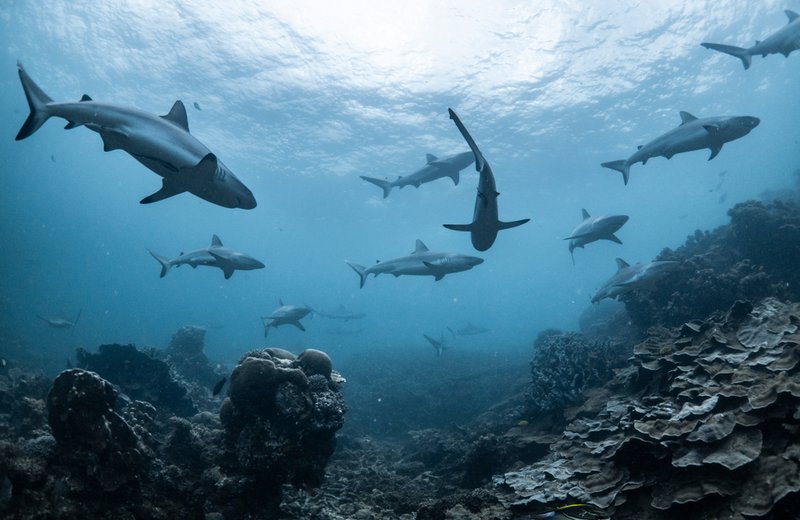
Imagine a tiger shark as a vital piece of a complex puzzle. If one piece shifts, it can scramble the entire image. In this case, climate change is that force causing disruptions. From altered food sources to changing migration patterns, tiger sharks are feeling the squeeze. So, let’s dive deeper into how climate change is affecting this magnificent species and what that means for our oceans.
Understanding the Tiger Shark’s Role in the Ecosystem
Tiger sharks are more than just sharp-toothed hunters; they play a crucial role in maintaining healthy ocean ecosystems. As apex predators, they help regulate the populations of various marine species. This balance is vital because if one species becomes too plentiful, it can lead to overgrazing or depletion of vital resources.
For instance, tiger sharks often feed on sea turtles and other marine life that graze on seagrass. If tiger shark populations decline, the number of turtles might increase, which can lead to overgrazing of seagrass beds. These beds are essential for other marine creatures, including fish that many people rely on for food. Without tiger sharks, the entire ecosystem could face serious upheaval.
But here’s the thing: climate change is altering the habitats that these sharks depend on. With rising sea temperatures and more acidic oceans, their food sources and breeding grounds are also shifting. If we want to protect tiger sharks, we need to understand their role in the ocean’s health and how climate change disrupts it.
Impacts of Rising Ocean Temperatures
One of the most direct effects of climate change on tiger sharks is the increase in ocean temperatures. Tiger sharks thrive in warmer waters, but there’s a tipping point. When temperatures rise too much, it can affect their metabolism and reproduction. Just like us, they need a certain range of conditions to thrive.
Warm waters can also lead to a decline in fish populations, which are a major food source for tiger sharks. If their prey shrinks, it can make it harder for these sharks to find enough food. Imagine trying to find your favorite dish at a restaurant, only to discover the menu has drastically changed. Frustrating, right?
In some regions, tiger sharks have already started to migrate to cooler waters, searching for a more suitable environment. This shift can lead to increased competition with other predators and strain existing marine ecosystems. If the sharks can’t adapt quickly enough, it could spell trouble for their populations.
Ocean Acidification and Its Effects
Another significant aspect of climate change is ocean acidification, primarily caused by increased levels of carbon dioxide in the atmosphere. As CO2 is absorbed by the oceans, it changes the water’s chemistry, affecting marine life in profound ways.
For tiger sharks, a more acidic ocean means a less healthy ecosystem overall. Many of the smaller creatures they rely on for food, like mollusks and crustaceans, struggle to survive in acidic conditions. Their shells become weaker, making them easier prey but less desirable for sharks. It’s a bit like eating a meal that’s lost all its flavor – not very satisfying!
Moreover, coral reefs, which provide essential habitats for marine life, are also suffering. Coral bleaching is a direct result of warm and acidic waters. If coral reefs decline, fish populations that depend on these habitats for shelter and food will also diminish. The knock-on effect could severely impact the tiger shark’s food supply.
Changes in Prey Availability
As climate change shakes up ocean habitats and food webs, the prey that tiger sharks hunt is also impacted. Many fish species are moving to cooler waters or adapting their breeding cycles in response to changing conditions. This means that tiger sharks must adjust their hunting patterns, which can be quite a challenge.
You might be wondering how this affects tiger sharks in the long run. If they can’t find enough food, it can lead to lower numbers of tiger sharks, which further disrupts the ecosystem. It’s like a game of Jenga; remove just one piece, and the whole tower could come tumbling down.
Some tiger sharks have started to change their hunting grounds, but that doesn’t guarantee success. They might end up competing with other predators, which can lead to additional stress on their populations. The quest for food becomes a race against time, with each shark trying to adapt before it’s too late.
The Threat of Overfishing
Overfishing is another significant threat to tiger sharks, and it’s exacerbated by climate change. As warmer waters change fish migration patterns, fishers may target different species, leading to increased fishing pressure on certain types of marine life. This can create imbalances in the food chain.
For tiger sharks, overfishing can mean not only a decline in their prey but also a reduction in their own numbers. Sharks are often accidentally caught in nets or targeted because of misconceptions about their danger to humans. In some areas, they are considered bycatch, leading to unintended deaths that further threaten their populations.
Moreover, some fisheries operate near critical habitats for tiger sharks, disrupting their breeding and nursery grounds. If these areas become too polluted or damaged, it could further diminish their chances of survival. It’s an ongoing battle, but understanding the impact of overfishing can help in creating better conservation strategies.
Conservation Efforts and Future Outlook
Despite the numerous challenges tiger sharks face due to climate change, there’s hope! Conservation efforts are underway to protect these magnificent creatures and their habitats. Various organizations work to reduce bycatch, minimize fishing pressures, and create marine protected areas where tiger sharks can thrive.
Public awareness is climbing too. More people are understanding the importance of apex predators like tiger sharks in maintaining healthy oceans. Through education and advocacy, we can push for policies that protect marine environments from the effects of climate change.
But here’s the sobering truth: Without immediate action to combat climate change, the future of tiger sharks remains uncertain. As the planet warms and ecosystems shift, we must prioritize conservation and sustainable practices to ensure these animals and their habitats survive for generations to come.
In conclusion, tiger sharks are essential guardians of our oceans. They face numerous challenges due to climate change, from rising temperatures and ocean acidification to changes in prey availability. By understanding these issues, we can take steps to protect not just tiger sharks, but the entire marine ecosystem they help sustain. After all, a healthy ocean means a healthy planet, and that’s something we all have a stake in.

